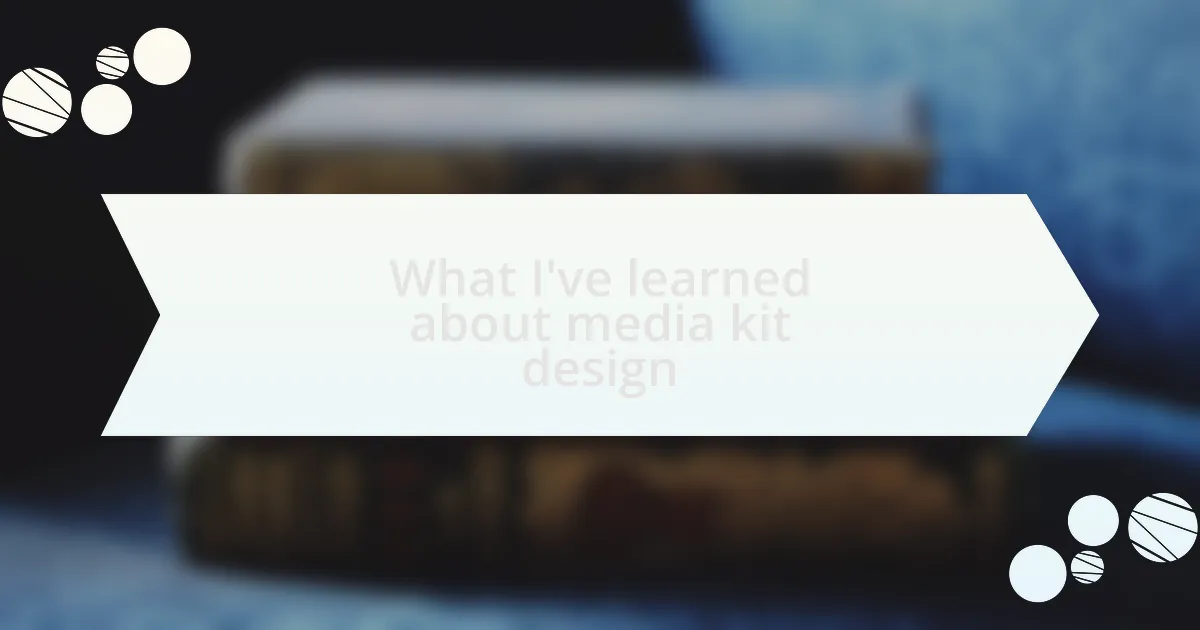Key takeaways:
- A media kit is crucial for authors as it serves to introduce their brand, showcase their achievements, and foster emotional connections with media outlets.
- Including personal insights and storytelling elements makes a media kit more relatable and engaging, enhancing the author’s credibility.
- Collaboration and feedback from fellow authors can help in effectively crafting a media kit that reflects an author’s journey and unique aspects of their writing.
- Balancing aesthetics and content is key; a visually appealing media kit should also authentically represent the author’s voice and mission.
Author: Clara Whitmore
Bio: Clara Whitmore is an acclaimed author known for her gripping psychological thrillers and lush literary fiction. With a background in psychology and a passion for storytelling, Clara intricately weaves complex characters and suspenseful plots that leave readers on the edge of their seats. Her debut novel, “Whispers in the Shadows,” was a finalist for the National Book Award and has won multiple accolades for its powerful exploration of the human psyche. Clara resides in Seattle, where she draws inspiration from the city’s moody landscapes and vibrant literary community. When she’s not writing, she enjoys hiking in the Pacific Northwest and engaging in local book clubs.
Understanding media kits
A media kit serves as a powerful tool for authors, encapsulating their brand and promoting their work in a concise format. I remember the first time I designed my own kit; it felt like introducing my work to the world in a polished way. It makes me wonder, how can one document capture not just my achievements but also the essence of my voice?
At its core, a media kit is not just about facts and figures; it’s an invitation for media outlets to engage with your story. I learned that sharing my journey—my struggles and triumphs—resonates more deeply than just listing book titles or accolades. Isn’t it intriguing to think about the emotional connection we can foster through such a simple document?
When I crafted mine, I realized that clarity and aesthetics play crucial roles. A well-organized kit with eye-catching visuals can make a lasting impression. Have you ever considered how the right design choices can elevate your narrative? I’ve found that investing time in perfecting these details truly pays off, as they reflect my dedication to my craft.
Importance of a media kit
A media kit may seem like just a collection of documents, but its importance cannot be overstated. I remember the moment I sent my first media kit to a local publisher; the anticipation was palpable. It felt like opening a door to new opportunities as I showcased not only my work but also my personality. Isn’t it fascinating how a single packet can open conversations and create potential partnerships?
Through my experience, I’ve learned that a well-crafted media kit serves as a bridge between authors and media outlets. When I included testimonials and personal insights alongside my achievements, it made my story relatable. It begs the question: how often do we overlook the power of storytelling in our promotional materials? I’ve come to appreciate that weaving in a narrative makes my media kit not just informative but also engaging.
Additionally, I discovered that a media kit is essential for establishing credibility. When I received positive feedback on the professionalism of my kit, it reassured me that I was taken seriously in a competitive field. It makes me reflect on the importance of presentation; wouldn’t it be easier to foster trust when everything feels curated and intentional? Each element in your kit should reinforce your identity as an author, making a compelling case for why someone should pay attention to your work.
Personal experiences with media kits
When I first created my media kit, I was overwhelmed by the options. I remember sitting in front of my computer, unsure of what to include. It was only after I reached out to fellow authors for advice that I realized the importance of focusing on key achievements and unique aspects of my writing. Have you ever felt lost during the creative process? Trusting others’ experiences taught me to view my kit as not just a self-promotion tool, but a reflection of my journey.
A memorable moment came shortly after sending my media kit to an organization for a speaking engagement. I received a call, and I could hear the excitement in the voice on the other end. They appreciated the personalized touch I had included, like snippets of my writing alongside my professional accolades. It hit me then: how often do we overlook the emotional connection we create through the details? Those small touches not only made my kit stand out but also gave me a sense of belonging within the community.
Reflecting on my journey, I recognize that the media kit has been a learning tool for me. Initially, I focused too much on aesthetics and not enough on the content. Through trial and error, I learned that clarity and authenticity speak volumes. Have you ever felt your content getting lost in presentation? I now strive for a balance, ensuring that while my media kit is visually appealing, it remains a true representation of my voice and mission as an author.

Leave a Reply